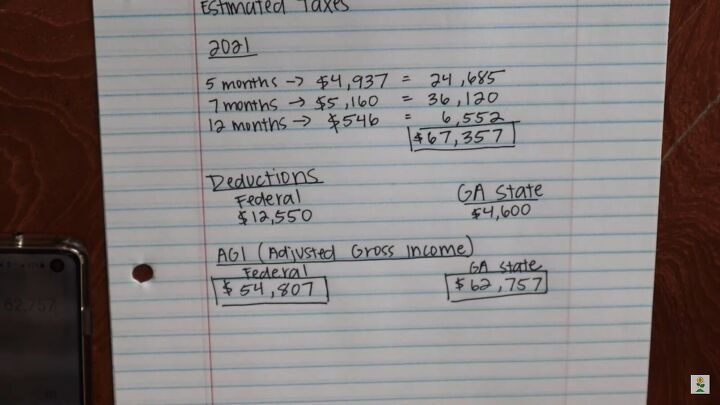How to Calculate Estimated Quarterly Tax Payments Quickly & Easily

If you have recently started working, or just do not know how to calculate estimated quarterly tax payments, this is the article for you. This is not relevant for everyone, but if you are like me and your income is considered unearned income, this should help you.
The bulk of my income comes from my full-time job, which is considered unearned income and/or a scholarship, so I am going to teach you how to calculate unearned income. I also do some online work, so I pay a little bit in self-employment taxes, and we will touch upon that as well.
To make it easier, I am going to use my own numbers. So let me break down what I will be earning for the year 2021 and how much I will need to save for taxes.
Gross income
Assuming I will stay at this job, for the first five months of 2021, I will be earning $4,937 a month. I get a raise with the pay scale every year, and my raise is in June, so I will be earning $5,160 a month for the other seven months of the year.
Other than my salary, I have to pay taxes on my health insurance, which is $546 a month. Now I multiply each amount by the number of months, add it all up and get my gross income for 2021: $67,357.
Deductions & adjusted gross income (AGI)
Now we have to consider deductions. There is a standard federal deduction ($12,550) and a standard deduction for my state, which is Georgia ($4,600). Once I subtract each of these amounts from my gross income, I will get my adjusted gross income, or AGI: federal and state.
State taxes
Let’s move on to taxes. The state taxes depend on where you live, obviously. For Georgia, the taxes are 5.75%, and I usually just round up to 6%. So each year I will need to pay 6% of my state AGI, which is $3,765. If we divide this by 12, that would be about $314 per month, so that is what I would set aside for Georgia taxes each month.
Federal taxes
Federal taxes are a little different because of tax brackets. Be careful: tax brackets vary from year to year, and the numbers I am using are from 2021, so you should check the tax brackets relevant for your year online.
The image shows the tax brackets relevant to me. My federal AGI falls within the 22% bracket, so I only need the first three.
For the brackets that my income goes over, 10% and 12%, I will just be taking the respective percentage of the difference between the top and the bottom of the bracket: $995 (10% of $9950) and $3669 (12% of $3574). For the bracket that my income falls into, the 22% one, I will be subtracting the bottom of the bracket from my actual federal AGI, and taking 22% of that. I got $3142.
Once I add up all three numbers that I got from the three brackets, I get my overall federal tax for the year, and by dividing it by 12 I get the monthly amount: $651 in my case.
Now we know how much we need to pay for both federal and state estimated taxes, and if I add them together I know how much I need to save for taxes: $965 a month.
When do you need to pay your taxes?
There are four due dates: the 15th of April, June, September, and January.
- In April, you are paying taxes for three months: January, February, and March.
- In June, you are paying for two: April and May.
- In September you are paying for three: June, July, and August.
- In January, you are paying for four months: September, October, November, and December.
All you need to do now is multiply these numbers by your monthly amount, whether federal or state. Then you can total these out and see how much you need to have saved for your taxes when the time comes to pay those.
This may not be 100% correct because it obviously depends on your current situation. If you are buying or selling the house, or something else is happening that will affect this, I 100% recommend that you go to a good CPA, because it can get complicated.
I myself had a year when I decided to do this on my own and messed it up and had to go to a CPA in any case. You can pay these taxes on your own, but for actually filing taxes, I think it is important to go to a CPA and make sure you are putting everything in right.
You can make federal payments through irs.gov, it is pretty straightforward. For the state, you should go to your state tax department's website on the 15th of the month.
Self-employment taxes
Now, for self-employment taxes. Even if you are self-employed, you still have to pay those quarterly estimated tax payments, otherwise, you will get a fee.
I write the bulk of my income off, so that is another reason to go to a CPA, at least once, to determine what you can write off. So here is the way to calculate your self-employment taxes that my CPA showed me.
The 92.35% is for the Social Security and Medicare tax. I don't have to worry about that with my full-time income, but some people may. The second number is the standard amount for self-employment taxes. I do not understand this too well myself, so I typically just put aside 20% just in case, and let my CPA handle it.
How to calculate estimated quarterly tax payments
Doing your own taxes is not always easy, but hopefully with this easy way to estimate quarterly tax payments you feel more confident. If you want to share your experience with taxes and give advice, feel free to leave a comment. And again, if you are unsure, I will always recommend going to a CPA.
























Comments
Join the conversation
There is a much more simplified explanation than you just gave. Sorry, i can figure most and divide, etc in my head, without calculator..Hope you get your taxes paid without a CPA😉